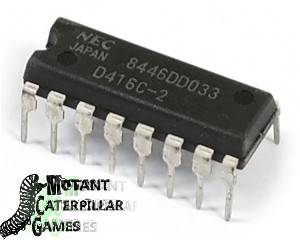The restoration of a 1980's Williams Defender arcade machine
Testing the 4116 memory
One of the questions asked quite a lot with Williams boards is how to test the often failing 4116 memory chips
Well the good news is that the 4116 shares the same 100% compatibility with the NEC D416C-2 4116 16Kx1 RAM chip, which was used on the ZX Spectrum
Here’s a nice picture for reference and a link to buy some online should you need some
So basically if you can get hold of any ZX Spectrum, 16k or 48k doesn’t matter, as the base 16k of all machines use D416C-2 chips
As the base 16k is required for the ZX Spectrum to boot, without the a dead or failing memory chip the machine will fail to boot
Voila! Cheapy 4116 memory tester ready to go and there’s some good details on the process on the Defender repair logs over at http://wiki.arcadeotaku.com/
Ideally I would hook up a Fluke 9010 6809e pod to the CPU socket and tell it to test the RAM in the address range 0h000-0hBFFF, but I didnt have a 6809e pod, but I did have a few Sinclair Spectrums handy. These take eight 4116 DRAM chips to provide the lower 16KB of RAM, on 16KB machines that is the only RAM in the system, the upper 32KB on machines with have 48KB is provided by another type of DRAM but the lower 16KB is critical to the machines ability to boot. These DRAMs are single bit chips, ie they have 2048 memory locations but can only hold a single bit in each one, ie either a 0 or a 1. These chips are usually ranged in rows of 8 where each row member contributes a single bit to the byte. So a quick test was to swap the 4116s into a Spectrum and see if it is able to boot. Any bad chip will blow a hole in every single byte in the lower 16KB of RAM and break the ability of the machine to even boot.
Happy fixing!
| Print article | This entry was posted by Judder on June 11, 2016 at 5:57 pm, and is filed under The Boards, Williams Defender restoration. Follow any responses to this post through RSS 2.0. You can skip to the end and leave a response. Pinging is currently not allowed. |
